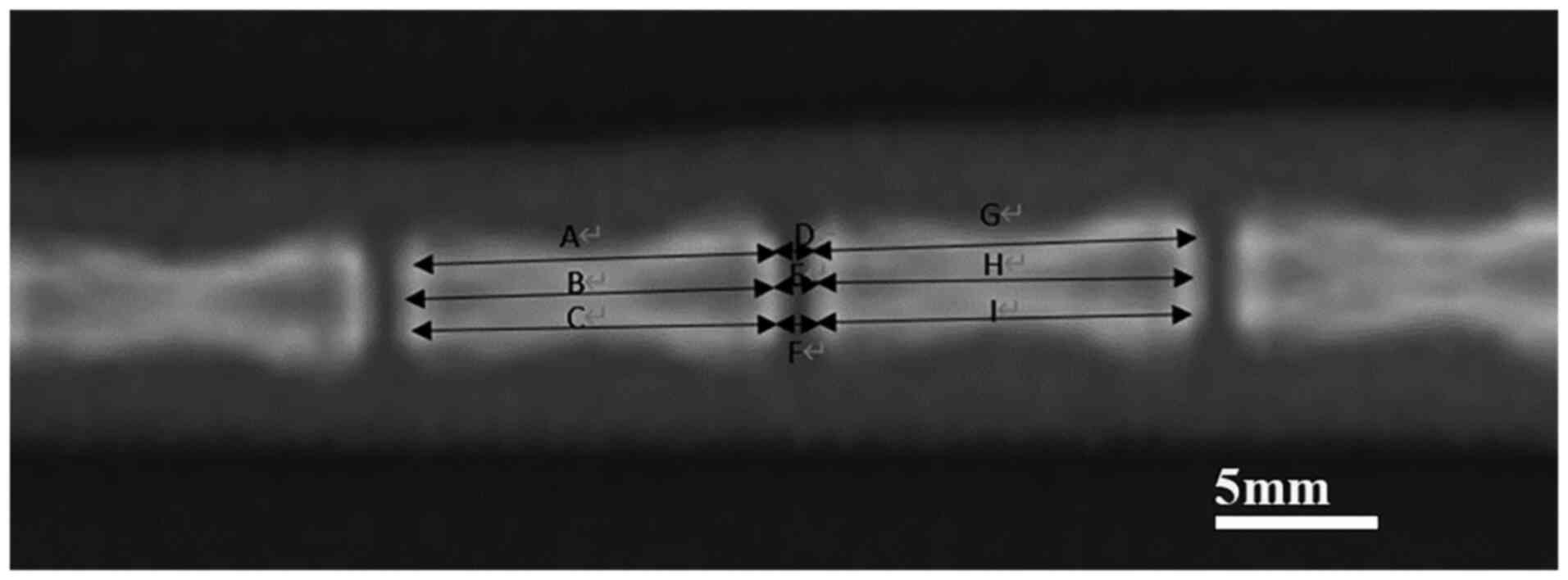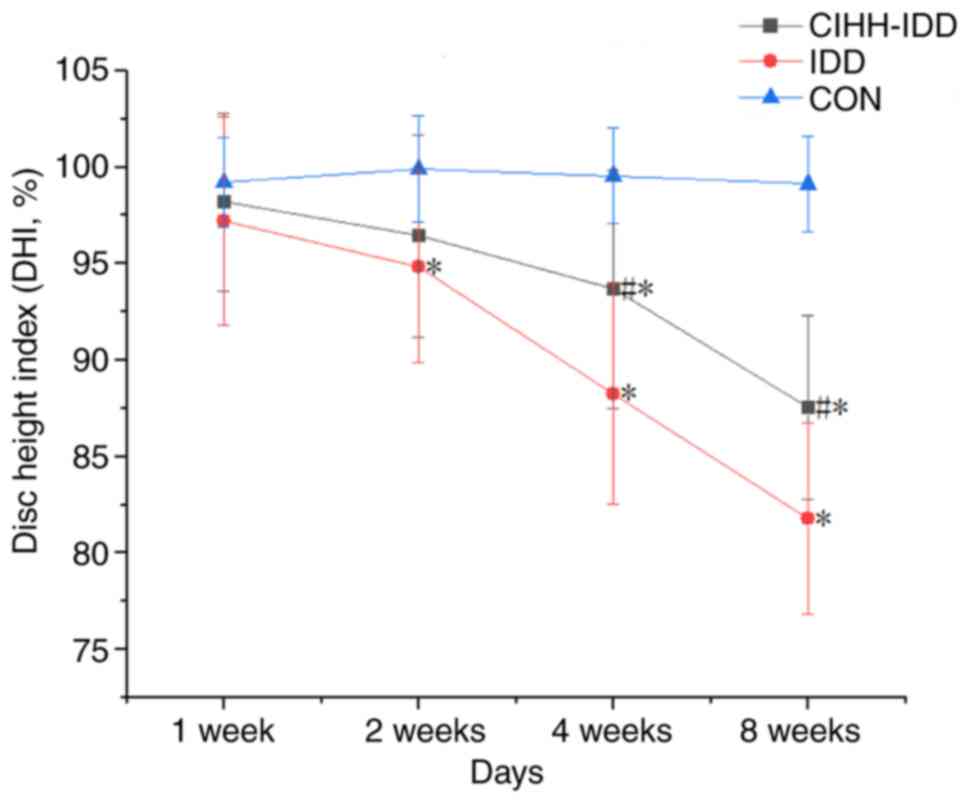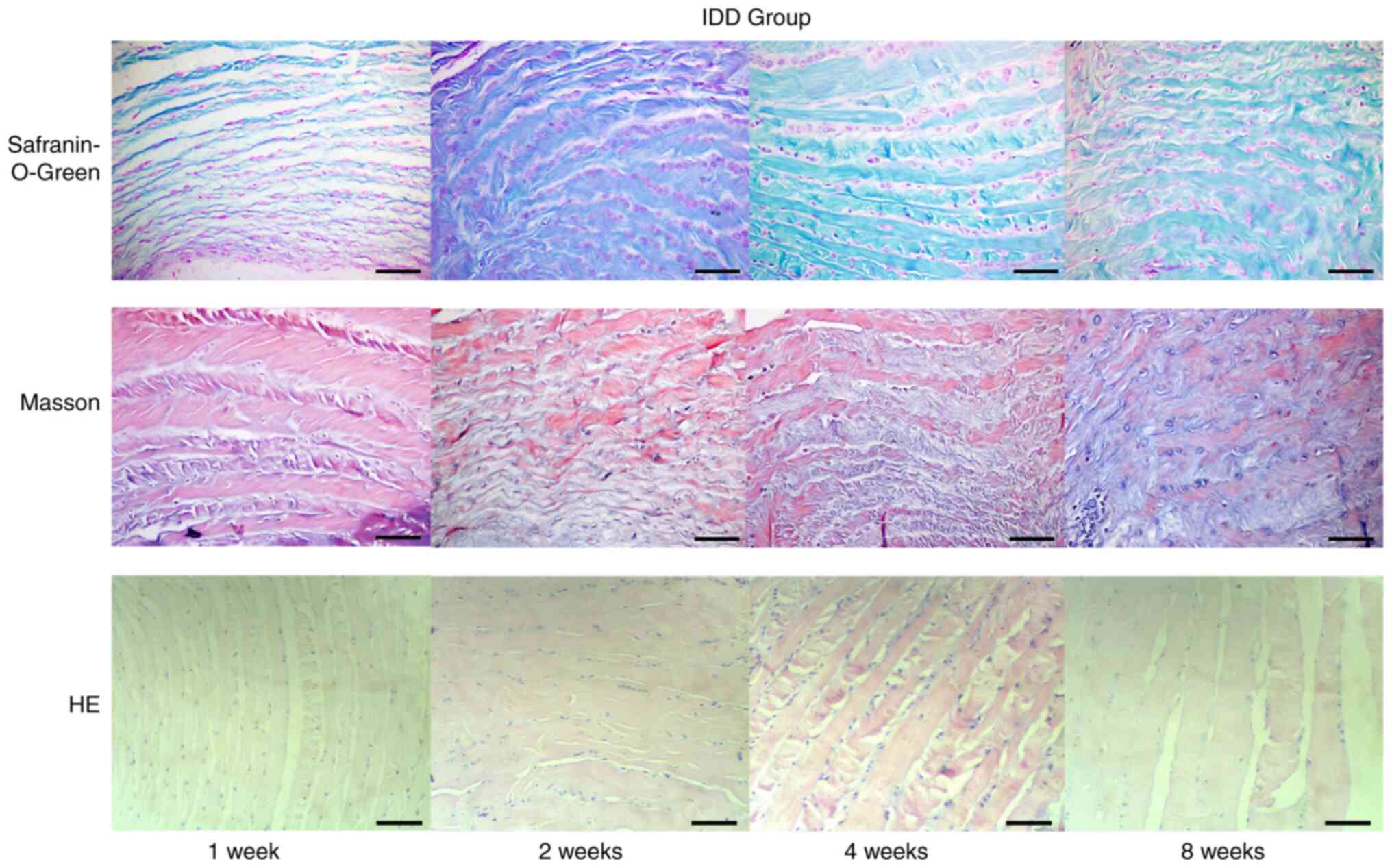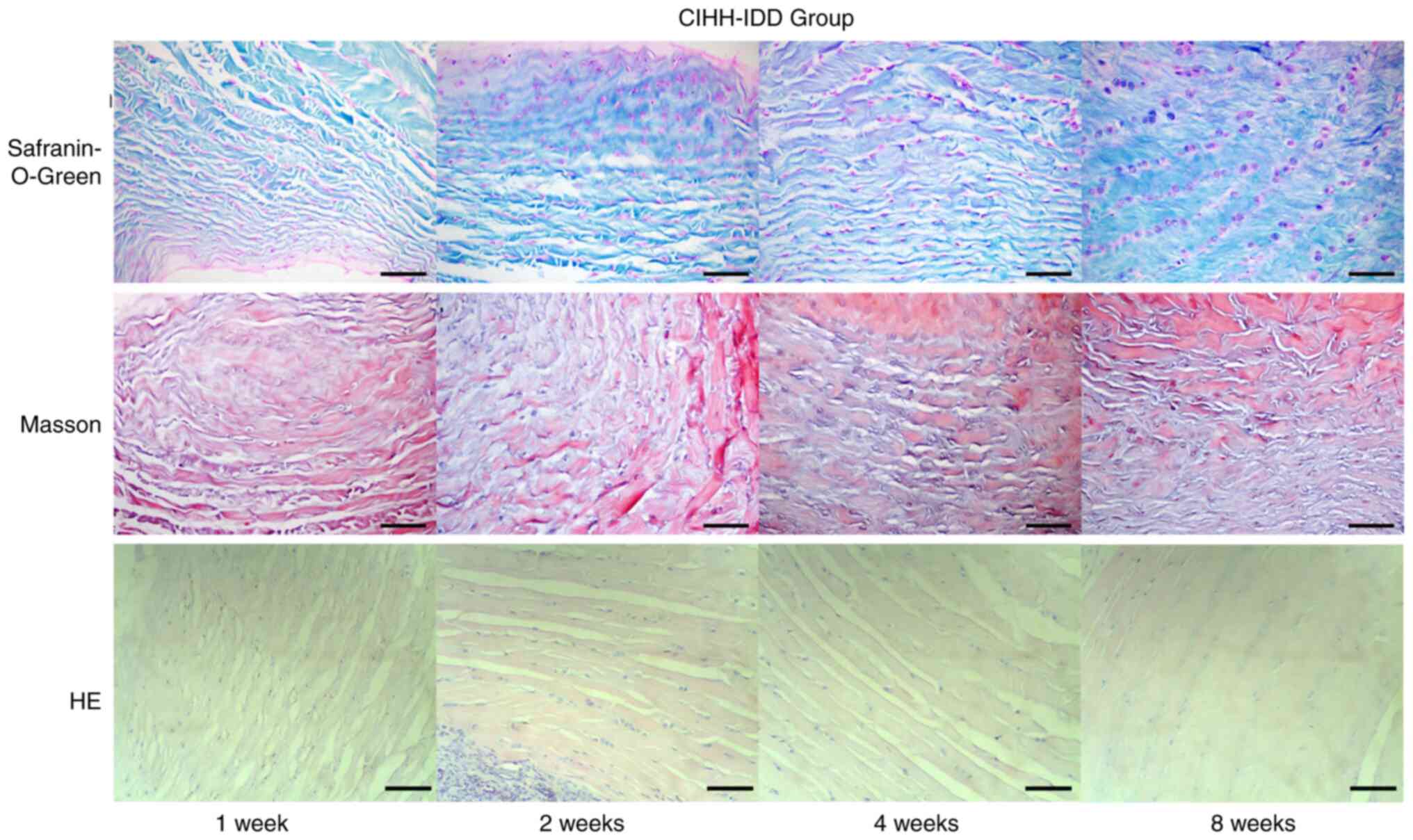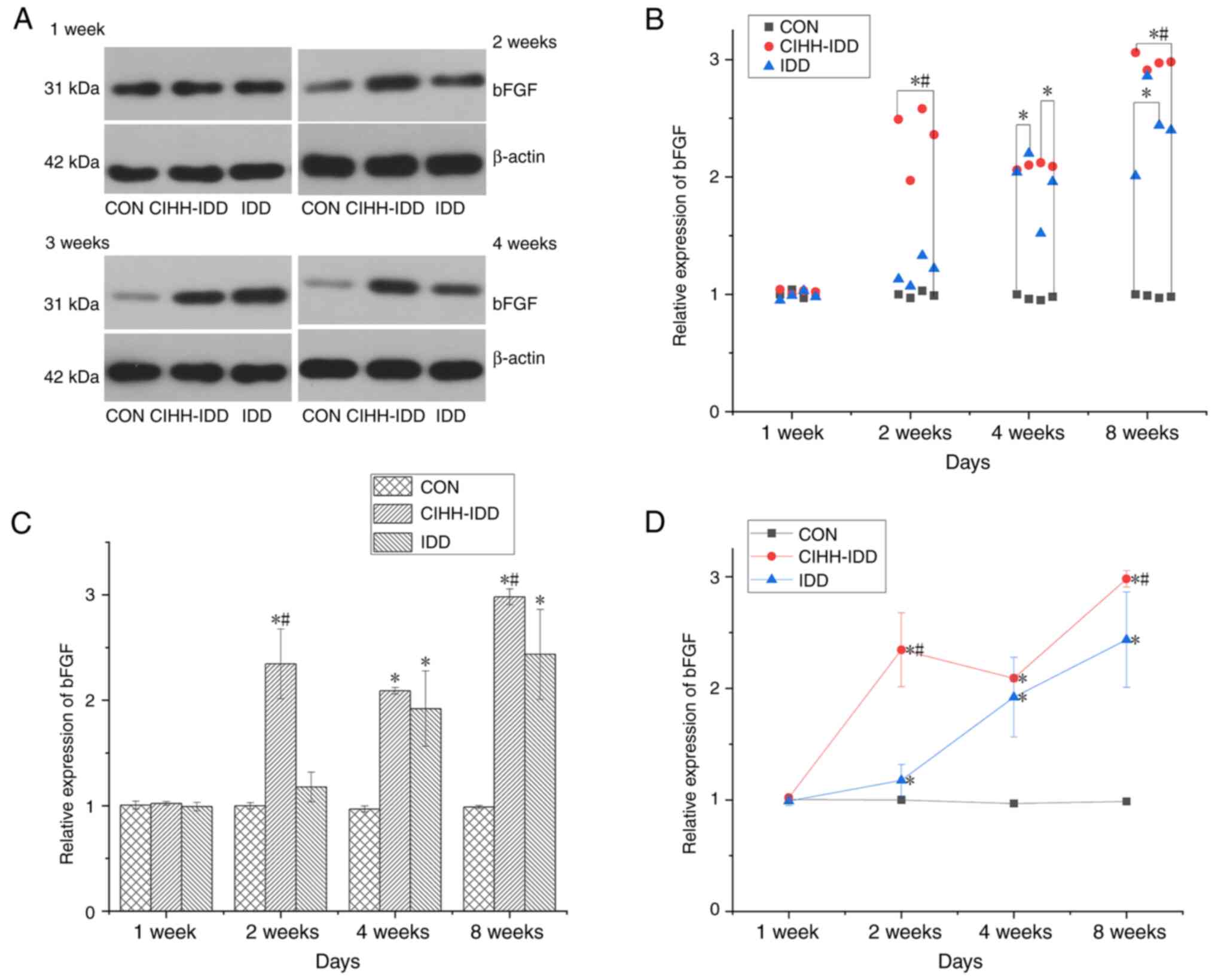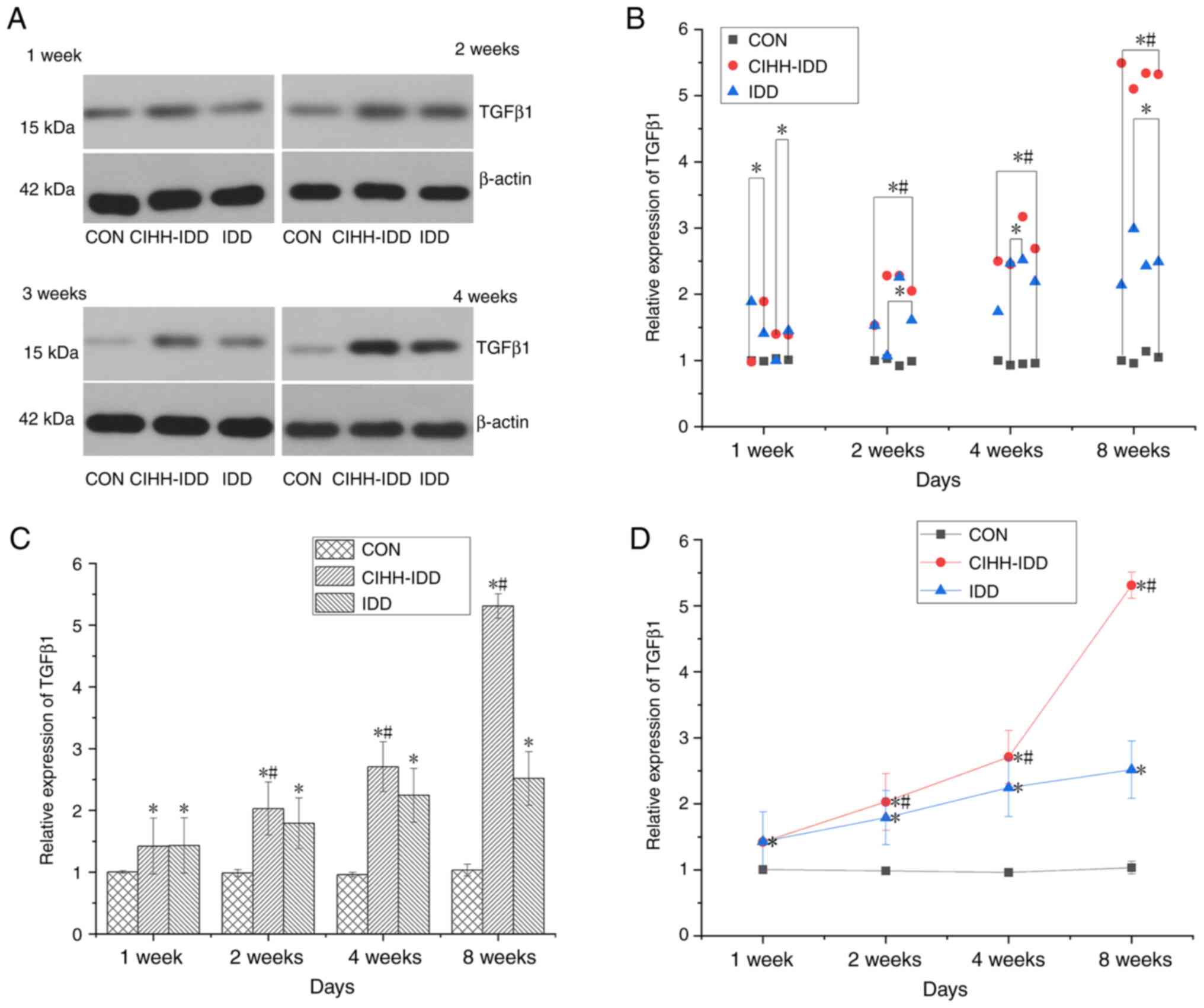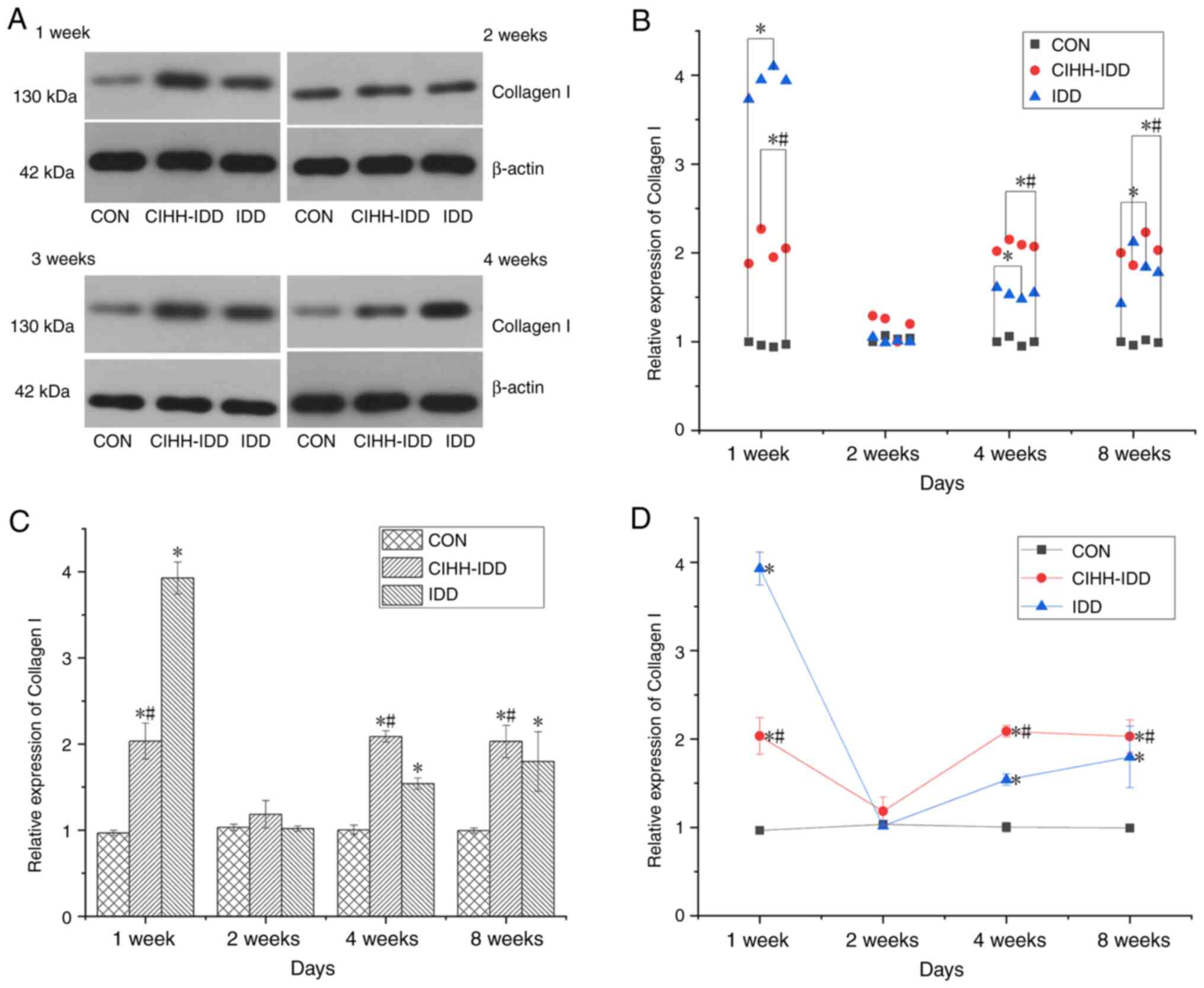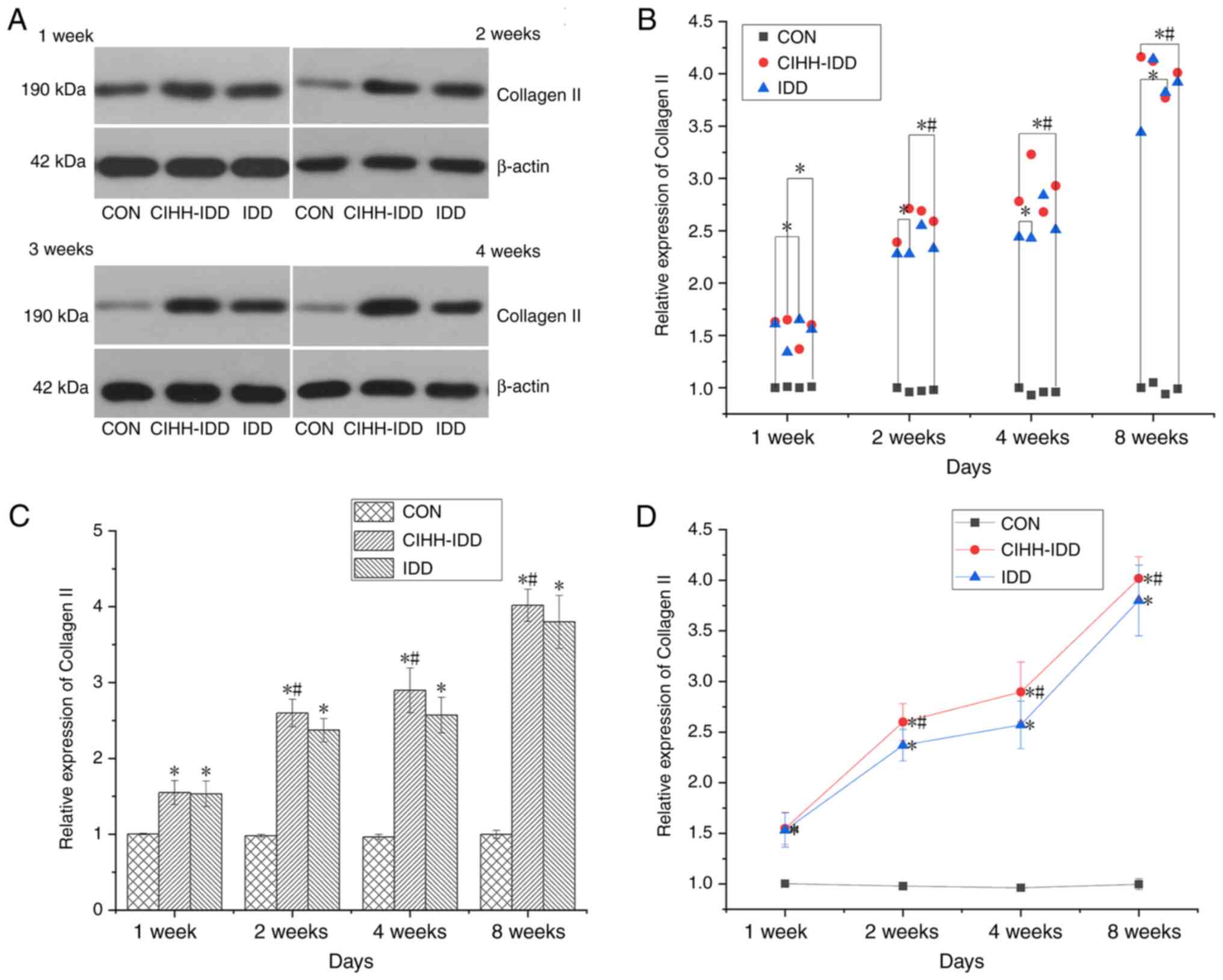|
1
|
GBD 2015 DALYs and HALE Collaborators, .
Global, regional, and national disability-adjusted life-years
(DALYs) for 315 diseases and injuries and healthy life expectancy
(HALE), 1990–2015: A systematic analysis for the global burden of
disease study 2015. Lancet. 388:1603–1658. 2016. View Article : Google Scholar : PubMed/NCBI
|
|
2
|
Kepler CK, Ponnappan RK, Tannoury CA,
Risbud MV and Anderson DG: The molecular basis of intervertebral
disc degeneration. Spine J. 13:318–330. 2013. View Article : Google Scholar : PubMed/NCBI
|
|
3
|
Risbud MV and Shapiro IM: Role of
cytokines in intervertebral disc degeneration: Pain and disc
content. Nat Rev Rheumatol. 10:44–56. 2014. View Article : Google Scholar : PubMed/NCBI
|
|
4
|
Masuda K, Aota Y, Muehleman C, Imai Y,
Okuma M, Thonar EJ, Andersson GB and An HS: A novel rabbit model of
mild, reproducible disc degeneration by an anulus needle puncture:
Correlation between the degree of disc injury and radiological and
histological appearances of disc degeneration. Spine (Phila Pa
1976). 30:5–14. 2005. View Article : Google Scholar : PubMed/NCBI
|
|
5
|
Shi M, Cui F, Liu AJ, Ma HJ, Cheng M, Song
SX, Yuan F, Li DP and Zhang Y: The protective effects of chronic
intermittent hypobaric hypoxia pretreatment against
collagen-induced arthritis in rats. J Inflamm (Lond). 12:232015.
View Article : Google Scholar : PubMed/NCBI
|
|
6
|
Roels B, Bentley DJ, Coste O, Mercier J
and Millet GP: Effects of intermittent hypoxic training on cycling
performance in well-trained athletes. Eur J Appl Physiol.
101:359–368. 2007. View Article : Google Scholar : PubMed/NCBI
|
|
7
|
Wei F, Zhong R, Pan X, Khaleel M, Hammoud
A, Zhou Z, Liu S, Sun H, Zhao Y, Zou X, et al: Computed
tomography-guided sub-end plate injection of pingyangmycin for a
novel rabbit model of slowly progressive disc degeneration. Spine
J. 19:e6–e18. 2019. View Article : Google Scholar : PubMed/NCBI
|
|
8
|
Yuan W, Che W, Jiang YQ, Yuan FL, Wang HR,
Zheng GL, Li XL and Dong J: Establishment of intervertebral disc
degeneration model induced by ischemic sub-endplate in rat tail.
Spine J. 15:1050–1059. 2015. View Article : Google Scholar : PubMed/NCBI
|
|
9
|
Kang R, Li H, Ringgaard S, Rickers K, Sun
H, Chen M, Xie L and Bünger C: Interference in the endplate
nutritional pathway causes intervertebral disc degeneration in an
immature porcine model. Int Orthop. 38:1011–1017. 2014. View Article : Google Scholar : PubMed/NCBI
|
|
10
|
Han B, Zhu K, Li FC, Xiao YX, Feng J, Shi
ZL, Lin M, Wang J and Chen QX: A simple disc degeneration model
induced by percutaneous needle puncture in the rat tail. Spine
(Phila Pa 1976). 33:1925–1934. 2008. View Article : Google Scholar : PubMed/NCBI
|
|
11
|
Schwan S, Ludtka C, Friedmann A, Heilmann
A, Baerthel A, Brehm W, Wiesner I, Meisel HJ and Goehre F:
Long-term pathology of ovine lumbar spine degeneration following
injury via percutaneous minimally invasive partial nucleotomy. J
Orthop Res. 37:2376–2388. 2019. View Article : Google Scholar : PubMed/NCBI
|
|
12
|
de Campos MF, de Oliveira CP, Neff CB, de
Toledo Correa OM, Pinhal MA and Rodrigues LM: Studies of molecular
changes in intervertebral disc degeneration in animal model. Acta
Ortop Bras. 24:16–21. 2016. View Article : Google Scholar : PubMed/NCBI
|
|
13
|
Ruiz-Fernández C, Francisco V, Pino J,
Mera A, González-Gay M, Gómez R, Lago F and Gualillo O: Molecular
relationships among obesity, inflammation and intervertebral disc
degeneration: Are adipokines the common link? Int J Mol Sci.
20:20302019. View Article : Google Scholar : PubMed/NCBI
|
|
14
|
Jin L, Balian G and Li XJ: Animal models
for disc degeneration-an update. Histol Histopathol. 33:543–554.
2018.PubMed/NCBI
|
|
15
|
Xu TT, Liao F, Jin HT, Tong PJ, Xiao LW
and Wu CL: Research advance on intervertebral disc degeneration and
cell death. Zhongguo Gu Shang. 28:673–678. 2015.(In Chinese).
PubMed/NCBI
|
|
16
|
Vergroesen PP, Kingma I, Emanuel KS,
Hoogendoorn RJ, Welting TJ, van Royen BJ, van Dieën JH and Smit TH:
Mechanics and biology in intervertebral disc degeneration: A
vicious circle. Osteoarthritis Cartilage. 23:1057–1070. 2015.
View Article : Google Scholar : PubMed/NCBI
|
|
17
|
Fujita N, Markova D, Anderson DG, Chiba K,
Toyama Y, Shapiro IM and Risbud MV: Expression of prolyl
hydroxylases (PHDs) is selectively controlled by HIF-1 and HIF-2
proteins in nucleus pulposus cells of the intervertebral disc:
distinct roles of PHD2 and PHD3 proteins in controlling HIF-1α
activity in hypoxia. J Biol Chem. 287:16975–16986. 2012. View Article : Google Scholar : PubMed/NCBI
|
|
18
|
Tissot van Patot MC, Serkova NJ, Haschke
M, Kominsky DJ, Roach RC, Christians U, Henthorn TK and Honigman B:
Enhanced leukocyte HIF-1alpha and HIF-1 DNA binding in humans after
rapid ascent to 4300 m. Free Radic Biol Med. 46:1551–1557. 2009.
View Article : Google Scholar : PubMed/NCBI
|
|
19
|
Meerson F, Pozharov V and Minyailenko T:
Superresistance against hypoxia after preliminary adaptation to
repeated stress. J Appl Physiol (1985). 76:1856–1861. 1994.
View Article : Google Scholar : PubMed/NCBI
|
|
20
|
Zhou JJ, Ma HJ, Liu Y, Guan Y, Maslov LN,
Li DP and Zhang Y: The anti-arrhythmic effect of chronic
intermittent hypobaric hypoxia in rats with metabolic syndrome
induced with fructose. Can J Physiol Pharmacol. 93:227–232. 2015.
View Article : Google Scholar : PubMed/NCBI
|
|
21
|
Kushwah N, Jain V, Deep S, Prasad D, Singh
SB and Khan N: Neuroprotective role of intermittent hypobaric
hypoxia in unpredictable chronic mild stress induced depression in
rats. PLoS One. 11:e01493092016. View Article : Google Scholar : PubMed/NCBI
|
|
22
|
Zhu XH, Yan HC, Zhang J, Qu HD, Qiu XS,
Chen L, Li SJ, Cao X, Bean JC, Chen LH, et al: Intermittent hypoxia
promotes hippocampal neurogenesis and produces antidepressant-like
effects in adult rats. J Neurosci. 30:12653–12663. 2010. View Article : Google Scholar : PubMed/NCBI
|
|
23
|
Ambalavanan N, Bulger A and Philips JB
III: Hypoxia-induced release of peptide growth factors from
neonatal porcine pulmonary artery smooth muscle cells. Biol
Neonate. 76:311–319. 1999. View Article : Google Scholar : PubMed/NCBI
|
|
24
|
Ruszkowska-Ciastek B, Sokup A, Socha M,
Ruprecht Z, Hałas L, Góralczyk B, Góralczyk K, Gadomska G and Rość
D: A preliminary evaluation of VEGF-A, VEGFR1 and VEGFR2 in
patients with well-controlled type 2 diabetes mellitus. J Zhejiang
Univ Sci B. 15:575–581. 2014. View Article : Google Scholar : PubMed/NCBI
|
|
25
|
Mahmood MQ, Reid D, Ward C, Muller HK,
Knight DA, Sohal SS and Walters EH: Transforming growth factor
(TGF) β1 and Smad signalling pathways: A likely key to
EMT-associated COPD pathogenesis. Respirology. 22:133–140. 2017.
View Article : Google Scholar : PubMed/NCBI
|
|
26
|
Zhang JC, Chen G, Chen L, Meng ZJ, Xiong
XZ, Liu HJ, Jin Y, Tao XN, Wu JH and Sun SW: TGF-β/BAMBI pathway
dysfunction contributes to peripheral Th17/Treg imbalance in
chronic obstructive pulmonary disease. Sci Rep. 6:319112016.
View Article : Google Scholar : PubMed/NCBI
|
|
27
|
Verhamme FM, Bracke KR, Joos GF and
Brusselle GG: Transforming growth factor-β superfamily in
obstructive lung diseases. more suspects than TGF-β alone. Am J
Respir Cell Mol Biol. 52:653–662. 2015. View Article : Google Scholar : PubMed/NCBI
|
|
28
|
Schietke R, Warnecke C, Wacker I, Schödel
J, Mole DR, Campean V, Amann K, Goppelt-Struebe M, Behrens J,
Eckardt KU and Wiesener MS: The lysyl oxidases LOX and LOXL2 are
necessary and sufficient to repress E-cadherin in hypoxia: Insights
into cellular transformation processes mediated by HIF-1. J Biol
Chem. 285:6658–6669. 2010. View Article : Google Scholar : PubMed/NCBI
|
|
29
|
Green RS, Lieb ME, Weintraub AS, Gacheru
SN, Rosenfield CL, Shah S, Kagan HM and Taubman MB: Identification
of lysyl oxidase and other platelet-derived growth factor-inducible
genes in vascular smooth muscle cells by differential screening.
Lab Invest. 73:476–482. 1995.PubMed/NCBI
|
|
30
|
Atsawasuwan P, Mochida Y, Katafuchi M,
Kaku M, Fong KS, Csiszar K and Yamauchi M: Lysyl oxidase binds
transforming growth factor-beta and regulates its signaling via
amine oxidase activity. J Biol Chem. 283:34229–34240. 2008.
View Article : Google Scholar : PubMed/NCBI
|
|
31
|
Rodríguez C, Alcudia JF, Martínez-González
J, Raposo B, Navarro MA and Badimon L: Lysyl oxidase (LOX)
down-regulation by TNFalpha: A new mechanism underlying
TNFalpha-induced endothelial dysfunction. Atherosclerosis.
196:558–564. 2008. View Article : Google Scholar : PubMed/NCBI
|
|
32
|
Xia W, Zhang LL, Mo J, Zhang W, Li HT, Luo
ZP and Yang HL: Effect of static compression loads on
intervertebral disc: An in vivo bent rat tail model. Orthop Surg.
10:134–143. 2018. View
Article : Google Scholar : PubMed/NCBI
|
|
33
|
Thompson JP, Oegema TR Jr and Bradford DS:
Stimulation of mature canine intervertebral disc by growth factors.
Spine (Phila Pa 1976). 16:253–260. 1991. View Article : Google Scholar : PubMed/NCBI
|
|
34
|
Nagano T, Yonenobu K, Miyamoto S, Tohyama
M and Ono K: Distribution of the basic fibroblast growth factor and
its receptor gene expression in normal and degenerated rat
intervertebral discs. Spine (Phila Pa 1976). 20:1972–1978. 1995.
View Article : Google Scholar : PubMed/NCBI
|
|
35
|
Tolonen J, Grönblad M, Vanharanta H, Virri
J, Guyer RD, Rytömaa T and Karaharju EO: Growth factor expression
in degenerated intervertebral disc tissue. An immunohistochemical
analysis of transforming growth factor beta, fibroblast growth
factor and platelet-derived growth factor. Eur Spine J. 15:588–596.
2006. View Article : Google Scholar : PubMed/NCBI
|
|
36
|
Pratsinis H and Kletsas D: PDGF, bFGF and
IGF-I stimulate the proliferation of intervertebral disc cells in
vitro via the activation of the ERK and Akt signaling pathways. Eur
Spine J. 16:1858–1866. 2007. View Article : Google Scholar : PubMed/NCBI
|
|
37
|
Bibby SR and Urban JP: Effect of nutrient
deprivation on the viability of intervertebral disc cells. Eur
Spine J. 13:695–701. 2004. View Article : Google Scholar : PubMed/NCBI
|
|
38
|
Singh K, Masuda K, Thonar EJ, An HS and
Cs-Szabo G: Age-related changes in the extracellular matrix of
nucleus pulposus and anulus fibrosus of human intervertebral disc.
Spine (Phila Pa 1976). 34:10–16. 2009. View Article : Google Scholar : PubMed/NCBI
|
|
39
|
Xie J, Li B, Yao B, Zhang P, Wang L, Lu H
and Song X: Transforming growth factor-β1-regulated Fas/FasL
pathway activation suppresses nucleus pulposus cell apoptosis in an
inflammatory environment. Biosci Rep. 40:BSR201917262020.
View Article : Google Scholar : PubMed/NCBI
|
|
40
|
Walsh AJ, Bradford DS and Lotz JC: In vivo
growth factor treatment of degenerated intervertebral discs. Spine
(Phila Pa 1976). 29:156–163. 2004. View Article : Google Scholar : PubMed/NCBI
|















